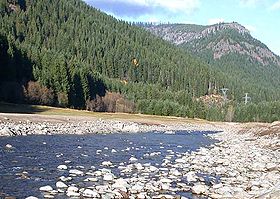Western Cascades
| Western Cascades | |
|---|---|

The Western Cascades have been highly eroded by rivers
|
|
| Geography | |
| Country | United States |
| State | Oregon |
The Western Cascades is a region of the U.S. state of Oregon between the Willamette Valley and the High Cascades. The range contains many extinct shield volcanoes, cinder cones and lava flows. The range is highly eroded and heavily forested.
The region was volcanically active from approximately 35 to 17 million years ago. The province is characterized as an older, deeply eroded volcanic range lying west of the more recent snow-covered High Cascade Range. They range in elevation from 1,700 feet (520 m) on the western margin to 5,800 feet (1,800 m) on the eastern margin. The Western Cascades began to form 40 million years ago with eruptions from a chain of volcanoes near the Eocene shoreline. As the regional angle of subduction steepened, volcanic activity gradually shifted to the east in the Miocene and Pliocene.
The Western Cascades are made up almost entirely of slightly deformed and partly altered volcanic flows and pyroclastic rocks which range in age from late Eocene to late Miocene. These rocks have been heavily dissected by erosion and the only evidence remaining of the many volcanoes from which they were erupted are occasional remnants of volcanic necks or plugs which mark former vents. There are also minor Pliocene to intracanyon lavas derived from the High Cascades or rare local vents. From youngest to oldest, the Western Cascade Range consists of four main units:
Portions of this article include public domain text from the USFS Deschutes & Ochoco National Forests - Crooked River National Grassland.
...
Wikipedia
